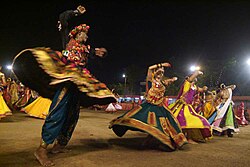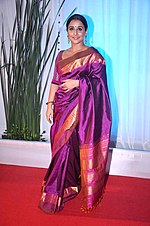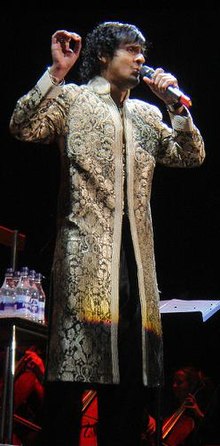Clothing in India
From Wikipedia, the free encyclopedia
| Part of a series on the |
| Culture of India |
|---|
 |
| History |
| People |
| Languages |
| Cuisine |
| Festivals |
| Religion |
| Sport |
Clothing in India varies from region to region depending on the ethnicity, geography, climate and cultural traditions of the people of that region. Historically, men and women's clothing has evolved from simple Langotas and loincloths to cover the body to elaborate costumes not only used in daily wear but also on festive occasions as well as rituals and dance performances. In urban areas, western clothing is common and uniformly worn by people of all strata. India also has a great diversity in terms of weaves, fibres, colours and material of clothing. Colour codes are followed in clothing based on the religion and ritual concerned. For instance, Hindu ladies wear white clothes to indicate mourning, whileParsis and Christians wear white to weddings.
Contents
[hide]History[edit]
India's recorded history of clothing goes back to the 5th millennium BC in the Indus Valley civilization where cotton was spun, woven and dyed. Bone needles and wooden spindles have been unearthed in excavations at the site.[1] The cotton industry in ancient India was well developed, and several of the methods survive until today. Herodotus, an ancient Greek historian described Indian cotton as "a wool exceeding in beauty and goodness that of sheep".[2] Indian cotton clothing was well adapted to the dry, hot summers of thesubcontinent. Most of the present knowledge of ancient Indian clothing comes from rock sculptures and paintings in cave monuments such as Ellora. These images show dancers and goddesses wearing what appears to be a dhoti wrap, a predecessor to the modern sari.The upper castes dressed themselves in fine muslin and wore gold ornaments[3] The Indus civilisation also knew the process of silk production. Recent analysis of Harappan silk fibres in beads have shown that silk was made by the process of reeling, a process known only to China until the early centuries AD.[4]
"The Indians use linen clothing, as says Nearchus, made from the flax taken from the trees, about which I have already spoken. And this flax is either whiter in colour than any other flax, or the people being black make the flax appear whiter. They have a linen frock reaching down halfway between the knee and the ankle, and a garment which is partly thrown round the shoulders and partly rolled round the head. The Indians who are very well-off wear earrings of ivory; for they do not all wear them. Nearchus says that the Indians dye their beards various colours; some that they may appear white as the whitest, others dark blue; others have them red, others purple, and others green. Those who are of any rank have umbrellas held over them in the summer. They wear shoes of white leather, elaborately worked, and the soles of their shoes are many-coloured and raised high, in order that they may appear taller."
Evidence from the 1st century AD shows some cultural exchanges with the Greeks. Indo-Greek influence is seen in the Greco-Buddhist art of the time. The Buddhas were portrayed as wearing the Greek himation, which is the forerunner of the modern saṃghāti that forms a part of the Kasaya of Buddhist monks.[6] During the Maurya andGupta period, the people continued to wear the three piece unstitched clothing as in Vedic times. The main items of clothing were the Antariya made of white cotton or muslin, tied to the waist by a sash called Kayabandh and a scarf called the Uttariya used to drape the top half of the body.[citation needed]
New trade routes, both overland and overseas, created a cultural exchange with Central Asia and Europe. Romans bought indigo for dyeing and cotton cloth as articles of clothing. Trade with China via the Silk road introduced silk textiles into India. The Chinese had a monopoly in the silk trade and kept its production process a trade secret. However, this monopoly ended when, according to legend, a Chinese princess smuggled mulberry seeds and silkworms in her headdress when she was sent to marry the king of Khotan (present day Xinjiang).[7] From there, the production of silk spread throughout Asia, and by AD 140, the practise had been established in India. Chanakya's treatise on public administration, the Arthashastra written around 3rd century BC, briefly describes the norms followed in silk weaving.[8]
A variety of weaving techniques were employed in ancient India, many of which survive to the present day. Silk and cotton were woven into various designs and motifs, each region developing its distinct style and technique. Famous among these weaving styles were theJamdani, Kasika vastra of Varanasi, butidar and the Ilkal saree.[citation needed] Brocades of silk were woven with gold and silver threads and were deeply influenced by Persian designs. The Mughals played a vital role in the enhancement of the art, and the paisley andLatifa Buti are fine examples of Mughal influence[9]
Dyeing of clothes in ancient India was practised as an art form. Five primary colours (Suddha-varnas) were identified and complex colours (Misra – varnas) were categorised by their many hues. Sensitivity was shown to the most subtlest of shades; the ancient treatise, Vishnudharmottara states five tones of white, namely Ivory, Jasmine, August moon, August clouds after the rain and the conch shell.[10] The commonly used dies were indigo(Nila), madder red and safflower.[11][a] The technique of mordant dyeing was prevalent in India since the second millennium BC.[12] Resist dyeing and Kalamkari techniques were hugely popular and such textiles were the chief exports.
Integral to the history of Indian clothing is the Kashmiri shawl. Kashmiri shawl varieties include the Shahtoosh, popularly known as the 'ring shawl' and the pashmina wool shawls, historically called pashm. Textiles of wool finds mention as long back as the Vedic times in association with Kashmir; the Rig Veda refers to the Valley of Sindh as being abundant in sheep[citation needed], [b] and the god Pushanhas been addressed as the 'weaver of garments',[13] which evolved into the term pashm for the wool of the area. Woolen shawls have been mentioned in Afghan texts of the 3rd century BC, but reference to the Kashmir work is done in the 16th century AD. The sultan of Kashmir, Zain-ul-Abidin is generally credited with the founding of the industry.[14] A story says that the Roman emperor Aurelianreceived a purple pallium from a Persian king, made of Asian wool of the finest quality.[citation needed] The shawls were dyed red or purple, red dye procured from cochineal insects and purple obtained by a mixture of red and blue from indigo[15] The most prized kashmiri shawls were the Jamavar and the Kanika Jamavar, woven using weaving spools with coloured thread called kani and a single shawl taking more than a year for completion and requiring 100 to 1500 kanis depending on the degree of elaboration.[13]
Indian textiles were traded from ancient times with China, Southeast Asia and the Roman Empire. The Periplus of the Erythraean Seamentions mallow cloth, muslins and coarse cottons.[16][c] Port towns like Masulipatnam and Barygaza won fame for its production of muslins and fine cloth. Trade with the Arabs who were middlemen in the spice trade between India and Europe brought Indian textiles into Europe, where it was favored by royalty in the 17th–18th century.[17] The Dutch, French and British East India Companies competed for monopoly of the spice trade in the Indian Ocean, but were posed with the problem of payment for spices, which was in gold or silver. To counter this problem, bullion was sent to India to trade for the textiles, a major portion of which were subsequently traded for spices in other trade posts, which then were traded along with the remaining textiles in London. Printed Indian calicos, chintz, muslins and patterned silk flooded the English market and in time the designs were copied onto imitation prints by English textile manufacturers, reducing the dependence on India.[18]
The British rule in India and the subsequent oppression following the Bengal Partition sparked a nationwide Swadeshi movement. One of the integral aims of the movement was to attain self-sufficiency, and to promote Indian goods while boycotting British goods in the market.[19] This was idealised in the production of Khadi. Khadi and its products were encouraged by the nationalist leaders over British goods, while also being seen as a means to empower the rural artisans.[20]
Woman's clothing[edit]
In India, woman's clothing varies widely and is closely associated with the local culture, religion and climate.
Traditional Indian clothing for women in the north and east are saris or ghagra cholis and (lehengas)[citation needed] while many south Indian women traditionally wear sari and children wear pattu pavadai.[citation needed] Saris made out of silk are considered the most elegant. Mumbai, formerly known as Bombay, is one of India's fashion capitals.[citation needed] In many rural parts of India, traditional clothing is worn. Women wear a sari, a long sheet of colourful cloth, draped over a simple or fancy blouse. Little girls wear a pavada. Both are often patterned. Bindi is a part of women's make-up.[citation needed] Indo-western clothing is the fusion of Western andSubcontinental fashion. Churidar, dupatta, Khara Dupatta, gamchha, kurta, mundum neriyathum, sherwani are among other clothes.
The traditional style of clothing in India varies with male or female distinctions. This is still followed in the rural areas, though is changing in the urban areas. Girls before puberty wear a long skirt (called langa/paawada in Andhra) and a short blouse, called a choli, above it.
Traditional clothing[edit]
Sari[edit]
Main article: Sari
A saree or sari[21][22] is a female garment in the Indian subcontinent.[23] A sari is a strip of unstitched cloth, ranging from four to nine meters in length, that is draped over the body in various styles. There are various traditional styles of saree: Sambalpuri Saree from East, Kanchipuram from South, Paithani from West and Banarasi from North among others.[24] The most common style is for the sari to be wrapped around the waist, with one end then draped over the shoulder baring the midriff.[23] The sari is usually worn over a petticoat.[25] Blouse may be "backless" or of a halter neck style. These are usually more dressy with a lot of embellishments such as mirrors or embroidery and may be worn on special occasions. Women in the armed forces, when wearing a sari uniform, don a half-sleeve shirt tucked in at the waist. Teenage girls wear half-sarees, a three piece set consisting of a langa, a choli and a stolewrapped over it like a saree. Women usually wear full sarees.
Saris are usually known with different names in different places. In Kerala, white saris with golden border, are known as kavanis and are worn on special occasions. A simple white sari, worn as a daily wear, is called a mundu. Saris are called pudavai in Tamil Nadu. In Karnataka, saris are called kupsas.[26]
Ghagra Choli (lehenga choli)[edit]
Main article: Ghagra choli
A Ghagra Choli or a Lehenga Choli is the traditional clothing of women in Rajasthan andGujarat.[citation needed] Punjabis also wear them and they are used in some of their folk dances. It is a combination of lehenga, a tight choli and an odhani. A lehenga is a form of long skirt which is pleated. It is usually embroidered or has a thick border at the bottom. Acholi is a blouse shell garment, which is cut to fit to the body and has short sleeves and a low neck.
Different styles of ghagra cholis are worn by the women, ranging from a simple cotton lehenga choli as a daily wear, a traditional ghagra with mirrors embellished usually worn during navratri for the garba dance or a fully embroidered lehenga worn during marriage ceremonies by the bride.
Salwar Kameez[edit]
Main article: Salwar kameez
Salwar is a generic description of the lower garment incorporating the Sindhi suthan, Dogri pajamma and the Kashmiri suthan.
The Salwar kameez is the traditional wear of women in Punjab, Haryana and Himachal Pradesh. The suthan, similar to the salwar is common in Sindh and Kashmir.[28] The salwar kameez has become the most popular dress for females. It consists of loose trousers (the salwar) narrow at the ankles, topped by a tunic top (the kameez).[28] It is named as "Punjabi suit" or simply "shalwar" in the north and "churidaar" in Southern India.[29] Women generally wear a dupatta or odani (Veil) with salwar kameez to cover their head and shoulders.[28] It is always worn with a scarf called a dupatta, which is used to cover the head and drawn over the bosom. The material for the dupatta usually depends upon that of the suit, and is generally of cotton, georgette, silk, chiffon among others.[citation needed] This dress is worn by almost every teenage girl in lieu of western clothes. The salwar kameez is most common in the northwestern part of India. Many actresses wear the salwar kameez in Bollywood movies.[citation needed]
Churidaar Kurta[edit]
Main article: Churidaar
Churidaar is a version of salwar, which is loose up to knees and then fits the calf below. A salwar is a baggy pyjama with pleats which gets narrow at the ankles whereas churidaar fits below the knees with horizontal gathers near the ankles.[30] Usually a long kurta, which goes below the knees, is worn with the churidaar.
Pattu Pavadai/Reshme Langa[edit]
Main article: Pattu pavadai
Pattu Pavadai or Langa davani is a traditional dress in south India and Rajasthan, usually worn by teenage and small girls. The pavada is a cone-shaped garment, usually of silk, that hangs down from the waist to the toes. It normally has a golden border at the bottom.
Girls in south India often wear pattu pavadai or Langa davani during traditional functions. Girls in Rajasthan wears this dress before marriage (and after marriage with sight modification in certain section of society. )
Langa - Voni[edit]
This is a type of South Indian dress mainly worn in Andhra Pradesh and also in some parts of Tamil Nadu, Kerala and Karnataka. This dress is a 3- piece apparel where Langa or Lehanga is the cone shaped long flowing skirt that covers the body from the waist, reaching the feet. In some cases, it might be as long as knees or just lower than the knees too. The second part is the blouse, or a jacket, that covers the upper part of the woman's body. There are many varieties in a blouse like the one that has long sleeves, short sleeves, sleeveless etc. The length of the blouse is usually short- from lower neck to a few inches above the belly button/ navel.
Mundum Neriyathum[edit]
Main article: Mundum Neriyathum
Mundum Neriyathum is the oldest remnant of the ancient form of the saree which covered only the lower part of the body, a traditional dress of women in Kerala, South India.[31][32] The basic traditional piece is the mundu or lower garment which is the ancient form of the saree denoted in Malayalam as 'Thuni' (meaning cloth), while the neriyathu forms the upper garment the mundu.[31][32]
Mekhela Sador[edit]
Main article: Mekhela chador
Mekhela Sador (Assamese: মেখেলা চাদৰ) is the traditional Assamese dress worn by women. It is worn by women of all ages.
There are three main pieces of cloth that are draped around the body.
The bottom portion, draped from the waist downwards is called the Mekhela (Assamese: মেখেলা). It is in the form of a sarong—very wide cylinder of cloth—that is folded into pleats to fit around the waist and tucked in. The folds are to the right, as opposed to the pleats in the Nivi style of the saree, which are folded to the left. Strings are never used to tie the mekhela around the waist, though an underskirt with a string is often used.
The top portion of the three-piece dress, called the Sador (Assamese: চাদৰ), is a long length of cloth that has one end tucked into the upper portion of the Mekhela and the rest draped over and around the rest of the body. The Sador is tucked in triangular folds. A fitted blouse is worn to cover the breasts.
The third piece is called a Riha, which is worn under the Sador. It is narrow in width. This traditional dress of the Assamese women are very famous for their exclusive patterns on the body and the border. Women wear them during important religious and ceremonious occasions of marriage. Riha is worn exactly like a Sador and is used as Orni.
Men's clothing[edit]
Traditional clothing[edit]
For men, traditional clothes are the Sherwani, Lungi, Kurta and Dhoti orPajama. Also, most recently Pant and shirt have also been accepted as traditional Indian dress by the Government of India.[33]
Dhoti[edit]
Main article: Dhoti
A dhoti is from four to six feet long white or colour strip of cotton. This traditional attire is mainly worn by men in villages.[34] It is held in place by a style of wrapping and sometimes with the help of a belt, ornamental and embroidered or a flat and simple one, around the waist.[35]
In south India men also wear long, white sarong like sheets of cloth known as Mundu. Its called dhotar in Marathi. In north and central Indian languages like Hindi, and Oriya, these are called Mundu, while in Telugu they are called Pancha, in Tamil they are called veshtiand in Kannada it is called Panche/Lungi. Over the dhoti, men wear shirts.
Panche or Lungi[edit]
A Lungi, also known as sarong, is a traditional garment of India. A Mundu is a lungi except that, it is always white.[35] It is either tucked in, over the waist, up to knee-length or is allowed to lie over and reach up to the ankle. It is usually tucked in when the person is working, in fields or workshops, and left open usually as a mark of respect, in worship places or when the person is around dignitaries.
Lungis, generally, are of two types: the open lungi and the stitched lungi. The open lungi is a plain sheet of cotton or silk, whereas, the stitched one has both of its open ends stitched together to form a tube like structure.
Though mostly worn by men, elderly women also prefer lungi to other garments owing to its good aeration.[36] It is mostly popular in south India, though people of Bangladesh, Brunei, Indonesia, Malaysia, Myanmar and Somalia also can be seen in lungis, because of the heat and humidity, which create an unpleasant climate for trousers, though trousers have now become common outside the house.[37]
Sherwani[edit]
Main article: Sherwani
A Sherwani is a long coat / jacket that usually sports exposed buttons through the length of the placket. The length is usually just below the knees and the jacket ends around high on the calf. The jacket has a Nehru collar,[38] which is a collar that stands up.[citation needed]The Sherwani is worn with tight fitting pants or trousers called churidars. Churidars are trousers that are loose around the hips and thighs, but are tight and gathered around the ankle.[33] Sherwani is usually worn during the wedding ceremonies by the groom and is usually cream, light ivory, or gold coloured[citation needed]. It may be embroidered with gold or silver. A scarf called a dupatta is sometimes added to the sherwani.
Headgear[edit]
The Indian turban or the pagri is worn in many regions in the country, incorporating various styles and designs depending on the place. Other types of headgear such as the Taqiyah and Gandhi cap are worn by different communities within the country to signify a common ideology or interest.
Dastar[edit]
Main article: Dastar
The Dastar, also known as pagri, is a turban worn by the Sikh community of India. Is a symbol of faith representing values such as valour, honour and spirituality among others. It is worn to protect the Sikh's long, uncut hair, the Kesh which is one of the Five Ks of Sikhism.[39] Over the years, the dastar has evolved into different styles pertaining to the various sects of Sikhism such as the Nihang and theNamdhari.[40]
Pheta[edit]
Main article: Pheta (turban)
Pheta is the Marathi name for turbans worn in the state of Maharashtra. Its usually worn during traditional ceremonies and occasions. It was a mandatory part of clothing in the past and have evolved into various styles in different regions.[41] The main types are the Puneri Pagadi, Kolhapuri and Mawali pheta.[41]
Mysore Peta[edit]
Main article: Mysore Peta
Originally worn by the kings of Mysore during formal meeting in durbar and in ceremonial processions during festivals, and meeting with foreign dignitaries, the Mysore peta has come to signify the cultural tradition of the Mysore and Kodagu district.[42] The Mysore University replaced the conventionalmortarboard used in graduation ceremonies with the traditional peta.[43]
Rajasthani pagari[edit]
Turbans in Rajasthan are called pagari. They are distinctive in style and colour, and indicate the caste, social class and region of the wearer. In the hot and dry regions, turbans are large and loose. The paggar is traditional in Mewar while the safa is to Marwar.[44] The colour of the pagaris have special importance and so does the pagari itself. In the past, saffron stood for valour and chivalry. A white turban stood for mourning. The exchange of a turban meant undying friendship.[45][46]
Gandhi cap[edit]
Main article: Gandhi cap
The Gandhi cap, a white coloured cap made of khadi was popularised by Mahatma Gandhiduring the Indian independence movement. The practice of wearing a Gandhi cap was carried on even after independence and became a symbolic tradition for politicians and social activists. The cap has been worn throughout history in many states such as Gujarat,Maharashtra, Uttar Pradesh and West Bengal and is still worn by many people without political significance.
Contemporary clothing[edit]
Western clothing made its foray into the Indian society during the times of the British Raj. Indian professionals opted to wear western clothing due to its relative comfort or due to regulations set then. By the turn of the 21st century, both western and Indian clothing had intermingled creating a unique style of clothing for the typical urban Indian population. Women started wearing more comfortable clothing and exposure to international fashion led to a fusion of western and Indian styles of clothing. Following the economic liberalisation, more jobs opened up, and created a demand for formal wear.
Women's clothing nowadays consist of both formal and casual wear such as gowns, pants, shirts and tops. Traditional Indian clothing such as the kurti have been combined with jeans to form part of casual attire. Fashion designers in India have blended several elements of Indian traditional designs into conventional western wear to create a unique style of contemporary Indian fashion. Both mini skirts and shorts are now worn by girls in bigger urban areas.[47]



















No comments:
Post a Comment